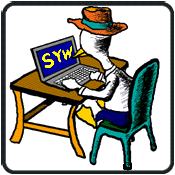4. SETTING UP THE ROUTER
Here are some general steps you are going to have to take, but make sure to read all the directions that come with your router as some routers may differ.
Plug in your router so it has power.
Then plug the Ethernet cable from modem into router. There will be a few Ethernet ports in your router; you want the one that is away from the rest. The modem connection goes here. All the other ports are for hardwire connections for a network. If your Internet connection is there and your router works, the router will broadcast the signal.
Now you have to decide whether your network is going to be strictly wireless or hybrid, meaning having both hardwire connections and wireless connections. For example, having one desktop near your router plugged in with an Ethernet cable and your laptop connected wirelessly. Whatever you decide, it may help to try hardwiring first to make sure everything is set up correctly.
Connecting the computers to the RouterIf you are doing an Ethernet for one computer, plug it in and see if the Internet works. For wireless, if you have an internal wireless adapter the computer should recognize the signal automatically.
If you have an external adapter, put in the CD that came with it and install all the drivers. When your computer is ready, it will tell you to it is safe to plug in your adapter.
When the computer says new hardware found, you will be able to proceed through the hardware installation wizard. If this finishes and everything is correct, a monitor with parentheses icon should appear in your start bar. This is your wireless connection.
Click on the new wireless icon and tell it to connect. Most will now require a password or other key to access the connection. This protects other wireless computers from your neighbor's house from connecting to your network.


